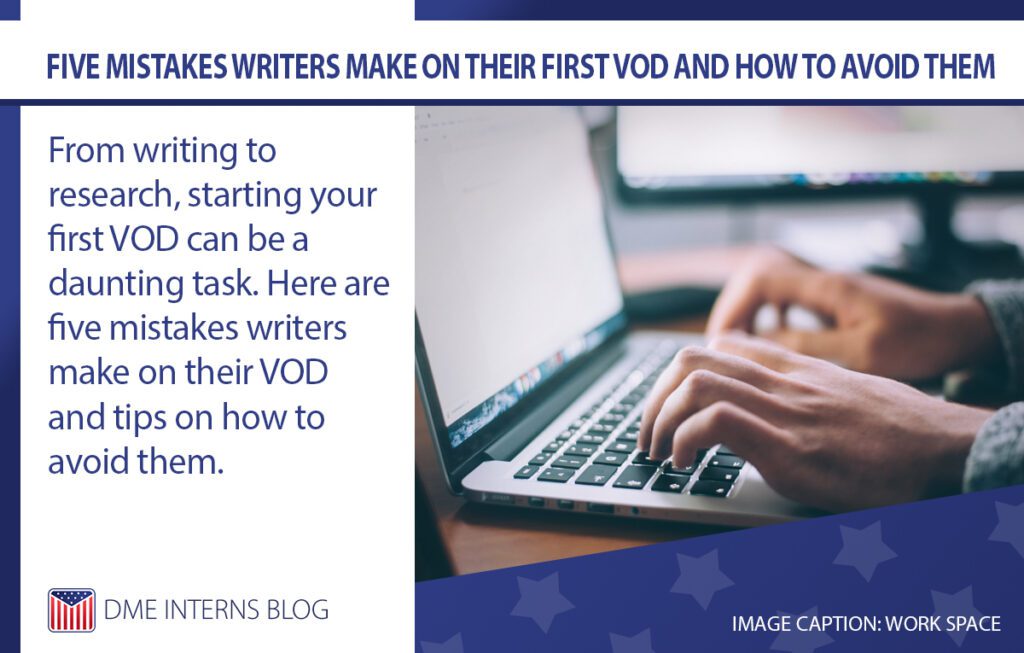1. Procedural Mistakes
Common mistakes new writers make on their first VOD card are forgetting to comment their role, using card labels or joining the card. As a writer, these tasks are important, as it tells everyone that your card is claimed so no one else will accidentally claim it. Remembering to use labels is also important, because the “documents attached” and “writer assigned” labels are visual cues that your card is active. The “help” label exists if you need input from your DHs or DOs.
To avoid these mistakes, make sure you comment your role and join your card before you attach the Veteran’s photos and your sources to the card. That way, before you even begin your VOD, your card will be properly formatted.
2. Common AP Style Mistakes
Another common mistake is not following the DME AP Style Guide. These mistakes include using the serial comma, also known as the Oxford comma. An Oxford comma is the last comma in a list of items. Many of us are accustomed to writing lists like this: “For his service, he earned a Distinguished Service Cross, three Air Medals, and a Purple Heart.” However, at DME, we write it like this: “For his service, he earned a Distinguished Service Cross, three Air Medals and a Purple Heart.”
To avoid these mistakes, familiarize yourself with the DME AP Style Guide document! This is found on the VOD Trello board in the “VOD Cheat Sheet” card under the “VODs Awaiting Approval” column. The DME AP Style Guide will have all the style information and instructions you need to adhere to DME’s writing style.
3. Photo Mistakes
As you start writing VODs, it’s easy to forget to upload high-quality photos, enough photos or photos of the Veteran in uniform. Making sure you complete all the photo requirements is essential before beginning your VOD, as your DHs and DOs cannot approve it without correct photos. As a guideline, make sure your photos are clear with discernible details or above 1024×768 resolution; the higher the resolution, the better it is. Three photos are required for VODs. This is for graphic designers, so they have enough photos to make a great graphic for the Veteran, but again, more is always better. Lastly, it is crucial to attach a photo of the Veteran in uniform. VOD graphics honor a Veteran’s service; this would not be possible without a photo of them in uniform.
To avoid these mistakes, closely look at your photos before uploading them. If you cannot make out details, then these are likely unusable for our purposes. For quantity, sometimes it may not be possible to find three photos of the Veteran. In this case, try finding photos related to the Veteran’s service. If they served on a ship or were in battle, try finding a photo of that ship or battle. These often work great for final photos.
4. Not Checking VAntage Point and Trello to Make Sure There Are No Duplicates
Before creating a VOD, make sure you search for that Veteran’s name in Trello and VAntage Point to ensure there are no duplicates, as we do not write about the same Veterans. This is important because if these slip by, your DHs or DOs will have to suspend your card.
As a side note, new interns will not have access to all the Trello boards like Special Projects and America 250. It is a good practice to ask DHs or DOs to double-check Trello for duplicates, as new interns will not see results from those boards. However, once you gain access to those boards, then it is a good practice to check Trello and VAntage Point for duplicate VODs.
5. Not Doing Thorough Research
As a writer, your job is to retell Veterans’ stories to honor their service. However, a mistake that can impede this goal is not properly researching your Veteran. Having incorrect or missing information not only does a disservice to the Veteran, but it also hurts the VA’s credibility.
An excellent way to avoid this is to find as many sources about your Veteran as you can. This can be interviews, news articles, obituaries or videos. The more sources, the better, because not only will it help you write a better VOD, but it will also give researchers a lead on ensuring your VOD is as accurate as possible.
Writer: Raymond Lin
Editors: Alexander Reza, Annabelle Colton
Graphic Designer: Kiki Kelley




